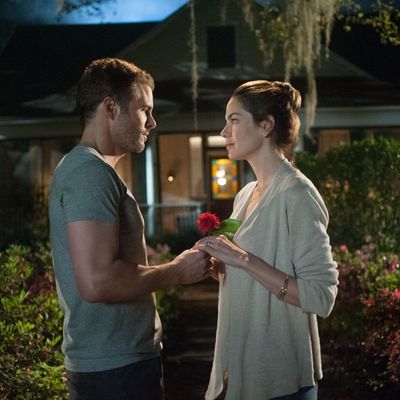
As presented in the opening scenes of the latest Nicholas Sparks adaptation The Best of Me, Dawson Cole, the film’s male protagonist, is the Nicholas Sparks–iest character you could imagine. Played as an adult by James Marsden, Dawson works on an oil rig, reads Stephen Hawking books in his spare time, sends cash money home in an envelope, and looks up at the stars at night; he’s a soulful, strapping, wandering, working-class romantic. And of course, he has a soul mate: The beautiful Amanda (played as an adult by the great Michelle Monaghan), now a wife and mother who also likes to look up at the stars, especially as an escape from her raging finance-bro hemorrhoid of a husband (Sebastian Arcelus).
When a mutual acquaintance of Amanda and Dawson’s passes away at the ripe old age of 92, he leaves behind his rural Louisiana cottage to the two of them. And thus, we learn of what happened lo these many years ago — how Amanda and Dawson came together, and what drove them apart. As these tales go, what we find out is not particularly melodramatic at first, though it is predictable. Amanda (played as a teen by Liana Liberato) was a beautiful, wealthy, headstrong, popular girl. Dawson (played as a teen by Luke Bracey, who looks so comically unlike James Marsden that it’s legitimately distracting) was a long-haired outcast from the wrong side of the tracks, with a white-trash family that looked like a gang of 19th-century train robbers. Both of them, however, wanted more out of life. Dawson liked to read physics textbooks on water towers by himself while the sun was setting; Amanda wanted to go to Tulane and study child psychology and public policy.
As I will never tire of saying, these things live or die by the chemistry of their leads. And both sets of leads — both the young and “old” versions of Amanda and Dawson — seem like they belong together. In particular, Monaghan strikes a good balance between regret and anticipation. Her wide, observant eyes and half-smile convey her hesitant desire; we sense that this is a woman with a complicated inner life, full of regrets. And just in case you don’t catch that sense of suggested regret, the film makes sure to give her lines like, “I had so many plans! I don’t know what happened!” (This is the point where I feel compelled to note that Monaghan also currently stars in the far superior, independent drama Fort Bliss, out now in theaters and on VOD. She gives one of the best performances of the year in that film; go see it.)
There’s a weird imbalance to The Best of Me that almost undoes the whole movie. For the most part, the film is lush and calm: Amanda and Dawson do a lot of circling around one another, and they spend a lot of time in lovely settings (rows of weeping willows, auburn sunsets, sparkly lakes, etc.) talking about what happened all those years ago … without actually telling us what happened all those years ago. They don’t have to tell us, of course; the flashbacks will eventually do so for us. But that also means that this otherwise quiet movie is back-loaded with wild melodrama; it deliberately goes off the rails in the final act, as both the crazy events of the past and the crazy events of the present converge. The imbalance doesn’t help the movie; it feels manipulative, rushed — as if somebody remembered that, this being a Nicholas Sparks movie, it hadn’t yet hit its Audience Teardrop Requisition Quota.
Of course, movies based on Sparks books are meant to be obvious and melodramatic. That’s why anybody watches them in the first place. But this also mandates that the wild plot twists and the revelations and the tearjerking climaxes be handled deftly; they’re part of the main attraction, after all. And in The Best of Me, the melodrama feels so hurried and half-baked that the end result isn’t just disappointing. It’s borderline infuriating.


